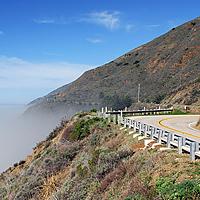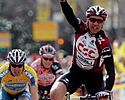
Recently on Cyclingnews.com |
Tour of California - 2.HC
USA, February 17-24, 2008
Third Tour of California combines 'old' with 'new
Mark Zalewski, North American Editor in Palo Alto
 |
Three years may not seem very 'old' for a cycling race, especially when Paris-Roubaix and the Tour have run 105 and 94 editions of their races, respectively. But in North America, where the half-life of major races is in question every year, three years of a race can make it look like a grizzled veteran. And with the third Tour of California bringing out some significant parcours changes, the comparison of 'old routes' versus 'new routes' seems justified; with all due respect to the spring classics, of course.
The new stages are the biggest news for this year's race, with a new prologue, a tough stage three course over Mt. Hamilton and the conversion of the final stage from a parade-like circuit race to a normal point-to-point stage. These more difficult routes, combined with the 'old standards' such as the run down the Pacific Coast Highway from Seaside to San Luis Obispo, will hopefully make for more exciting racing along California's beautiful coast - possibly resulting in more solo stage finishes to counterbalance the usual field sprints.
Cast of characters
Returning to defend his title, the first time this will be possible, is the current U.S. road champion Levi Leipheimer. And for the third time he comes with a new team, Astana. But the team may not be as new after first glance, as the team is made up of about half of the old Discovery Channel team, with Johan Bruyneel running the show. Leipheimer will have a strong supporting cast with him, including former Discovery riders Janez Brajkovic, Vladimir Goussev, José Luis Rubiera, as well as new teammate Chris Horner.
"The Tour of California has grown exponentially in the first two years, probably setting an unprecedented rate of growth than any race in the world," Leipheimer told Cyclingnews at the team's training camp last month. "I've seen the affect it has had on my community, and it was a dream for me to win it last year. The only thing that could be as satisfying for me is to see a teammate win. Astana is definitely sending a very strong team, and I've some hard training this year to be able to repeat, so we are ready."
Technically it will be Astana's first time in California, but for Team High Road, it will only be that in name only. The former T-Mobile team has a successful history at this race, and is now technically a 'home team,' with the management company setting up shop in San Luis Obispo. The new version of this team has a lot of firepower behind it, including former U.S. road champion George Hincapie. For the first time he will be working only for himself at a stage race, and will have a good supporting cast in three-time world time trial champion Michael Rogers, and former teammates Michael Barry and the up-and-coming John Devine.
 |
This race is important for a lot of teams as one of the first tests of the season; but for the Slipstream-Chipotle team, this is the first home race with their revamped team. Jonathan Vaughters is going to want to see some return on the team's investment in riders such as Tom Danielson, David Millar, David Zabriskie and Christian Vande Velde. Other than Millar, the team is fielding all American riders.
For the die hard cycling fans, the chance to see several reigning and former world champions is worth the trip out to the race. Quick Step's Paolo Bettini returns for the second year, this time bringing along an in-form Tom Boonen. Team CSC brings time trial world champion Fabian Cancellara, while Rabobank will have three-time World Champion Oscar Freire looking for sprint victories.
Team CSC could be the strongest threat to Leipheimers title defense. The squad put up a strong push in last year's event, with three individual stage wins from JJ Haedo and a second overall from Jens Voigt last year. They'll also have American Bobby Julich on board along with the always aggressive Stuart O'Grady and last year's third place finisher, Jason McCartney.
While there are plenty of American riders on the European teams with the chance to win, this race gives the domestic squads a chance to play with the big boys. In the past Toyota-United has benefited the most from this with their top sprinters netting stage wins and upping the team's exposure. But beyond this, the domestic teams have done little to affect the overall outcome of the race. This year, BMC has added a few names to bolster its squad in an effort to be able to do this, such as former Discovery rider Tony Cruz. Health Net-Maxxis will also be trying to change this will riders such as last year's NRC winner Australian Rory Sutherland.
Setting the stage
 |
The changes to the parcours of the race might not affect the end result of the race compared to the previous two, but they could affect the way in which the contenders approach the race. The opening prologue across the flat campus of Stanford University in Palo Alto is a complete turnaround from the Telegraph Hill climb up to Coit Tower in San Francisco of previous years. The likely outcome will be a leader board separated by tenths of seconds rather than multiple seconds, making any time bonus sprints on subsequent stages much more relevant.
In the previous two years the question that has always come up is, why not take the race over some of California's majestic mountains? Well the answer is that the race is far too early in the season and going up the Sierra Nevadas would likely rip the early season legs off the riders. But the race has answered the call for more climbing in a reasonable way with the much-touted third stage from Modesto to San Jose. This stage will feature five rated climbs, including the infamous Sierra Road climb less than 20 miles from the finish like. But it is the addition of Mt. Hamilton to this stage, with around 2,000 feet of climbing, that will really make the difference.
Finally, this year's tour will finish differently, with the replacement of the circuit race (or a parade with a field sprint) by a 150km point-to-point stage with a category three climb and two time bonus sprints.
Be sure to follow all of the daily racing action via Cyclingnews' live web updates direct from the race course.
For a thumbnail gallery of these images, click here
- Jens Voigt came close to the win in 2007, losing by just seconds to Leipheimer
- The riders will get more climbing this year, compared to previous editions.
Images by Mitch Clinton/www.clintonphoto.com
- Stage four will twist along the coast taking in plenty of fabulous scenery.
- The riders may not get a chance to enjoy the great views from the Pacific Coast Highway.
- Don't look down!
- There may be a few cows along the way.

